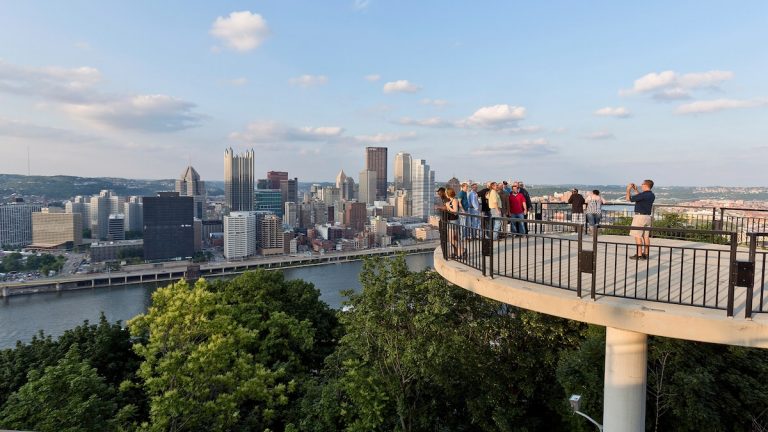As more urban hikers hit the trails of Miami’s new Underline and Houston’s Buffalo Bayou Greenway Connector, more are rediscovering Pittsburgh’s unique urban challenge. More than 700 steps wind their way up the steep hills surrounding the city, passing through dense residential neighborhoods and dense foliage. “The Stairs,” as locals call them, offer spectacular views of downtown Pittsburgh and may make you feel like you’re standing on a peak in the nearby Allegheny Mountains.
History of Pittsburgh’s Stairs
From the early 1900s through the 1970s, Pittsburgh was one of America’s leading steel-manufacturing cities, producing over 20 million tons of steel annually by the early 20th century. The hills of western Pennsylvania were rich in iron ore, the main raw material for steel, but locating factories in these hills led Pittsburgh to build some of the steepest, most breathtaking roads in America.
For thousands of steelworkers who lived on the hills surrounding the city’s core, the “commute” to the factories downtown was a brutal ordeal. In addition to building a series of mechanical cable cars that connected the top of the hills to downtown, the city built long staircases so Pittsburghers could get to and from work without straining their calf muscles. While these stairs were not “easy” to climb, the flat steps were a slightly easier alternative to the unforgiving inclines of Pittsburgh’s steep streets.
The Carr Street staircase leads to the west end of Pittsburgh, where in fall and winter the old stone foundations of the houses are visible.
Photo by Matthew Jacob
In total, over 700 public staircases were created, making Pittsburgh the city with the most stairs in America, with a cumulative height estimated at approximately 24,000 feet, just 5,000 feet shy of the summit of Mount Everest.
When the steel industry collapsed in the mid-1980s, Pittsburgh lost much of its population (and tax base). The rise of the automobile had already caused many Pittsburghers to abandon stairs as their primary means of commuting to work. And as the city continued to lose residents and revenue, it stopped maintaining its stairs, and many fell into disrepair. So some residents whose only access to their homes was via stairs were faced with a question: “do I stay or do I go?”
But in 2015, geography systems professor Bob Regan published “Pittsburgh Steps: The Story of the City’s Public Stairs,” a historical guidebook that brought hundreds of forgotten staircases to the public’s attention decades after the city had stopped maintaining or even recording them.
After cycling hundreds of miles around the city to track down and document the lost staircases, Regan submitted his mapping data to the city government, which used it to create a public, interactive map of all the city’s available staircases. This summer, local stair enthusiasts Laura Zulowski, Charles Succop and Matthew Jacob teamed up to publish Pittsburgh’s Stairs: A History and Guide, a sequel that includes original photos of the staircases and suggested walking routes that include some of the most interesting staircases and impressive city views.
Take a walk in the sky above America’s highest city.
4 Ways to Experience Pittsburgh’s Stairs
Of all Pittsburgh’s neighborhoods, the South Side Slopes has the greatest concentration of stairs. Once a year, the South Side Slopes Neighborhood Association brings together hundreds of urban hikers for StepTrek, a community adventure where city residents and tourists are given a map and invited to walk two carefully selected trails up and down the stairs of the South Side Slopes, home to some of Pittsburgh’s most incredible views and scenic curiosities. A 23-year-old local tradition, the angular urban hike doubles as a fundraiser for the association’s neighborhood project, which is painting a mosaic tile artwork on the Oakley Street steps.
“We also use a portion of the donations towards staircase cleaning and preservation projects,” says board member Jami Suzara. “StepTrek is great and fun, but stairs are also a part of our daily lives. Some homes here can only be reached by public stairs.”
For first-time Pittsburgh hikers, Zurowski recommends the Yard Way, one of the city’s longest staircases, which offers direct access to Winters Park’s lush greenery and panoramic views of the Monongahela River, the downtown skyscrapers and the hills to the north of the city.
One of Pittsburgh’s longest staircases, Rising Main’s 370 steps take hikers to an elevation gain of nearly 300 feet.
Photo by Matthew Jacob
Another stunning view comes from the St. Michael Street Steps, where visitors are amazed by the view of the huge green church spire towering above the homes and woodland of South Side Slopes, with the river flowing behind it. “When you’re walking down South Side Slopes, you’re so high up that you often turn around and think, ‘Wow, what a view!'” says Zulowski, adding that some of the best unexpected views he’s stumbled upon during his adventures down the stairs have been glimpsed through alleyways between homes or gaps in the trees.
(Explore America’s secret urban trails.)
But some of Pittsburgh’s stair traverses are more about challenge than scenery, and one of the toughest examples is Rising Main. Located in the city’s northwestern Fineview neighborhood, Rising Main has about 370 steps, climbing more than 300 feet in elevation in just 2/10 of a mile. Once you reach the top of the steps, you can stumble down Lanark Street and enjoy the city views from Fineview Field, while also soaking up the sunshine and breeze just like a mountaineer.
Miles Howard is an author and writer on outdoor recreation and founder of Boston’s Walking City Trails. He also publishes Mind The Moss, a weekly newsletter about unusual hikes in New England.
Source link


